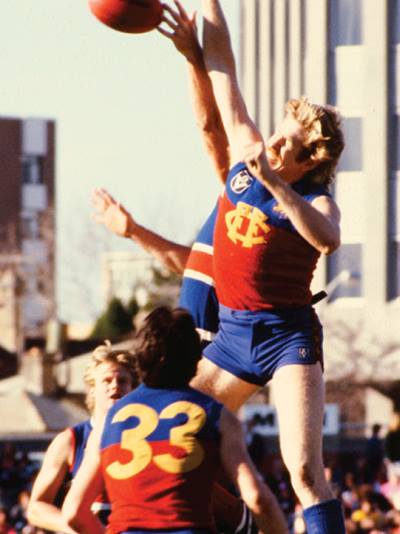What it's like to lose your football club
21 Aug 2020 | Russell Holmesby
Footy is an Aussie religion. For those who follow the sport, your team often becomes part of your identity. So what happens when you lose that? The Death of Fitzroy Football Club by Russell Holmesby, outlines the reasons why Fitzroy FC, one of the founding clubs of the VFL in 1896, lost its way and eventually was merged with the Brisbane Bears. The book covers the spread of years from the seventies, through a period when the club was strong on the field in the early eighties, to the club’s death, at the end of the 1996 season.
What is it like to lose your footy club? The short answer is that you can’t get close to understanding such a loss unless you have been through it.
Many years ago, I remember Rohan Connolly, then a senior footy writer at The Age, grumbling after his side, Essendon, had just been beaten again. The Bombers were in the midst of an unprecedented 14-game losing streak. “Now I know what you must have felt like when St Kilda was going really badly in the 1980s,” he said.

Not so, Rohan. Essendon fans have never seen their club close to extinction, as I had as a St Kilda supporter. In the mid-1980s the then-club president told me St Kilda would fold in three weeks’ time if it didn’t receive an injection of cash. That footballing-near-death moment was nothing like the agony suffered by Fitzroy’s ever-faithful devotees. Their club’s demise was slow torture. Agonising.
As a football writer in the final years of the Lions, I watched and sometimes reported on elements of this sorry tale, but it is not until you sit down and track every step along the way that you start to appreciate what a truly noble battle club loyalists had fought.
They tried everything to save the club, often going well outside the square with innovative attempts to ensure their survival. In most cases those attempts were either thwarted, blocked or not assisted by the League. In its early years, responding to the financial plights of numerous clubs, the AFL Commission favoured a form of economic rationalism whose defining feature would be a reduction in the number of Melbourne-based clubs.
Fitzroy people can look back on those times and reasonably conclude that the same thing wouldn’t happen now, because the AFL needs 18 clubs providing nine games a week to satisfy the demands of its television “stakeholders”. Fitzroy was $1.5 million in the red in 1996 (that figure was reported as $3 million at the time), and although that deficit amounts to a larger relative sum now, today we see clubs still functioning with debts up to $12 million. On top of that, the AFL has poured close to $100 million into the expansion clubs of the 2010s—Greater Western Sydney and Gold Coast Suns.
This is not just a story of a club with a terminal illness. Despite Fitzroy’s inevitably sad conclusion, the tale of its last days should not just be about off-field travails and misery. The Lions had many great players and a few well-coached, very fine teams during those final decades, and with even a small dose of the luck that always eluded them, could quite possibly have won a couple of flags in the early- and mid-1980s.
Those happy times warrant re-telling.
In addition to my own research and plenty of conversations with key players in this story, I was able to call upon the interviews with past players and coaches which featured in Inside Football from 2000 to 2017. I am grateful to Craig Hutchison, whose company, Crocmedia, owns SEN, the owner of Inside Football when it ceased publication; Craig instantly gave permission to use extracts of those interviews for this book. During that period, Inside Football published interviews with more than 450 people across the League spectrum. Mal Brown and then David Rhys-Jones were the men asking the questions, with me, as editor, doing the research.
People often told me I could conduct those interviews myself, but I always felt that the interviewees, often men with strong fraternal links to fellow players like Mal and Rhys, would open up more to their contemporaries. Of those interviews, 35 were Fitzroy players, coaches or officials.
Stars like Bernie Quinlan, Matt Rendell, Paul Roos, Gary Pert, Mick Conlan and coaches David Parkin and Robert Walls provided valuable insights to the club during those years, and another former Inside Football contributor, Robert Shaw, kindly filled in the blanks from his years in charge of the Roys (1991 to 1994). I thank all of those people for their interviews and also former presidents Frank Bibby, Leon Wiegard and Dyson Hore-Lacy for agreeing to be interviewed for this book. Being the president of a football club is a thankless task at any time, but those charting a path through the troubled waters of Fitzroy’s final decades had an even tougher job than most.
Hore-Lacy’s book, Fitzroy (Lion Books, 2000), was an invaluable source, as it forensically recorded the machinations that led up to 1996. As he pointed out, nobody has challenged what he wrote.
To get a sense of Fitzroy lore, and revive memories of the suburb this wandering club called home, I spent a day touring Fitzroy with fellow footy history buff Rod Connolly. The Napier Hotel and the Standard Hotel in the now-fashionable inner-northern suburb of Melbourne still feature old team pictures and memorabilia, with The Standard displaying the original ‘Fitzroy Football Ground’ sign that once adorned the ground. We ended with a walk around the Brunswick Street Oval, and sat in its magnificent grandstand, now fully restored to its Victorian-era grandeur. Despite it being a cloudless, sunny day, we tried to visualise what it would have been like on a muddy July afternoon, with the smells from the nearby briquette factory wafting across the ground. As a youngster I witnessed a few VFL matches at Brunswick Street, and indeed was present for the last ever Fitzroy game at the ground, against St Kilda in round 17, 1966.
For those of us whose earliest memories of footy start in the 1960s, the bottom three each year. It wasn’t always so. In the early days of League football, Fitzroy was a powerhouse club. In the nine seasons from 1898 to 1906 it won three premiership pennants and was runner-up three times. Before the formation of the League in 1897, Fitzroy had also been the VFA premier in 1895 and legend has it that the club cast the final, deciding vote on the move of Collingwood, South Melbourne, Essendon, Geelong, Melbourne, and Carlton—with St Kilda invited to join them—to break away from the VFA and form the VFL.
By the end of 1922 Fitzroy had seven VFL premierships to its name. In the 1930s it had fielded sides featuring three Brownlow medallists—Haydn Bunton, Wilfred ‘Chicken’ Smallhorn and Dinny Ryan. This was a club with proud traditions. Its last flag was won in 1944, with Fred Hughson as captain-coach.
In its last two decades of League football, it was an incredible club spirit and pride that kept Fitzroy going at a time when it seemed the club’s administrators were constantly in discussions with rivals about possible merger options. That Fitzroy would finally be absorbed into a Queensland club, and one just 10 years in existence, remains, in my view, a travesty.
The AFL commissioners of that time claimed they had the broader vision for the competition and point smugly to the AFL’s incredible financial success in the past two decades as justification of their summary actions in 1996. The title and sub-title of Ross Oakley’s book, The Phoenix Rises— The amazing story of the salvation of Australian Football (Slattery Media, 2014) stridently peddles the view that the treatment of Fitzroy was a means to an end. What can’t be measured in dollars and cents is the damage to the fabric of footy itself, and the alienation of not only Fitzroy fans, but also thousands of others who lost faith in the game’s values.
Oakley has been demonised over the years, but he genuinely believes the direction pursued by commissioner Graeme Samuel and himself is justified by the AFL’s wealth and prosperity in the 21st century. That level of prosperity is unarguable, but the need to sacrifice Fitzroy in 1996 is still questionable.
When Hore-Lacy and Colin Hobbs (the club’s last football director) read this manuscript, they weren’t exaggerating when they said that it “re-opened some old wounds”.
The cynics will say that Fitzroy’s fate was inevitable, but it can equally be argued that the club was corralled and forced down a path engineered by the AFL. To its credit, the Brisbane club has done much to encourage and celebrate its links with the rich, decorated history of Fitzroy, and to keep the memory of Fitzroy alive, although it continues to puzzle why the club does not play in Fitzroy’s old maroon and blue guernsey when playing in Melbourne.
In a different sense, Bill Atherton has been the keeper of the flickering flame via the Fitzroy team which plays in the Victorian Amateur Football Association competition, wearing the famous colours. The amateur club’s website proclaims: “Established in 1883 and still going strong in the Fitzroy community.” Its logo includes a silhouette of the great Bunton.
Fitzroy Football Club’s story, above all else, is a cautionary one. Football likes to describe itself as a business or an industry, but it is really neither—it is so much more, its following based on heart and of soul, characteristics conveniently overlooked by an AFL which treated one of its foundation clubs as something akin to a disposable nut and bolt manufacturer.
When I told The Age’s football writer Greg Baum about this project, he declared that the end product could be used by the AFL—and all its subsidiary organisations—as a manual for how NOT to handle a football club. He was right, but equally, I hope this story invites people to stop and remember the joyous moments that compete with the regrets when old Roys think of their grand club’s final days.
This is an edited extract from The Death of Fitzroy Football Club by Russell Holmesby
Available now in all good bookstores and online
Click here for your preferred online retailer



